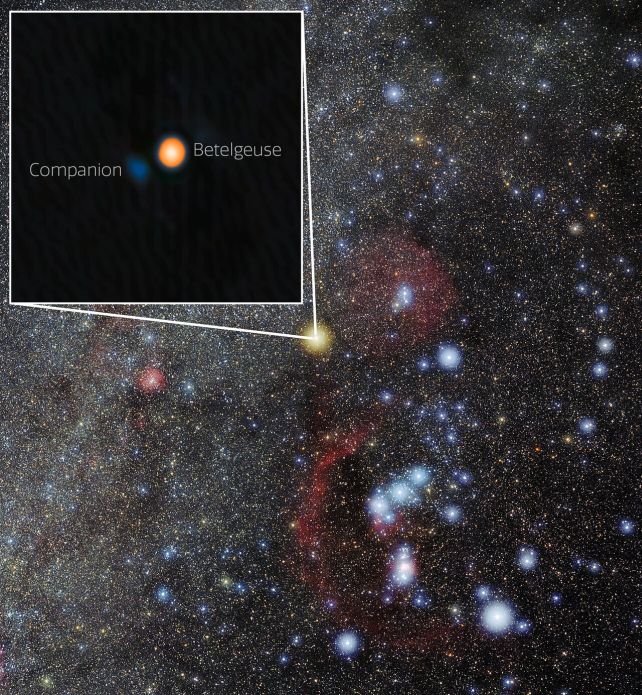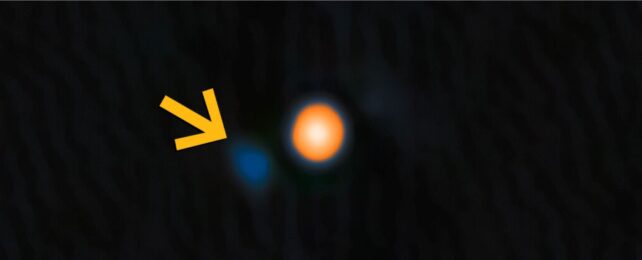At least one mystery surrounding the red giant Betelgeuse can now be put to bed. Astronomers have finally laid eyes on a small, dim binary companion whipping around the massive sun.
The observations of this smaller, fainter star perfectly match predictions of its properties based on Betelgeuse's behavior. Given that the name Betelgeuse means 'Hand of the Giantess' in Arabic, a team of researchers proposes that the companion, circling this 'hand', be named Siwarha – 'Her Bracelet'.
It's a detection that astronomers thought might not be possible at all, making it a spectacular achievement.
Related: Red Supergiant Star Betelgeuse Was A Different Color Just 2,000 Years Ago
"This detection was at the very extremes of what can be accomplished with Gemini in terms of high-angular resolution imaging, and it worked," says Steve Howell, an astrophysicist at NASA Ames Research Center. "This now opens the door for other observational pursuits of a similar nature."

Located at an uncertain but near distance of around 548 light-years away in the constellation of Orion, Betelgeuse is one of the biggest and brightest stars in Earth's sky. It's a bloated beast at the end of its lifespan, clocking in at a mass somewhere between 16.5 and 19 times our own Sun's mass yet a radius of around 764 times our own star's.
At a mere 10 million years old, the giant might seem quite young for a senior, especially given that there are stars out there nearly as old as the 13.8 billion-year age of the Universe. That's because Betelgeuse is massive. More massive stars burn much hotter, brighter, and faster than the smaller ones, ending their lives in spectacular supernova fireworks and the formation of a neutron star or black hole.
Betelgeuse, therefore, represents a rare jewel in the sparkling cosmos: a short-lived star in the fleeting last stage of its lifespan, close enough to Earth to observe in detail.

Those observations have certainly ponied up the goods, too: Betelgeuse is pretty weird. There was the mysterious great dimming, in which the star's luminosity dropped by a whopping 35 percent; an observation that was later traced to a huge ejection of dust that obscured the star's light as it cooled.
Betelgeuse's light fluctuates in other ways, too. It has two dominant periods of fluctuating brightness – one every 400 days, the other about six years. The 400-day period is its main one, caused by internal pulsations within the star itself.
The secondary, six-year period has been a little more difficult to resolve since it didn't fit internal activity.
Several recent papers, however, proposed that a small, close binary companion between around one and two times the mass of the Sun might be responsible, predicting that the best time to observe this object would be in December 2024.
This is where things get tricky. Because Betelgeuse is so large and bright, finding a smaller, dimmer object right next to it is not easy. Howell and his colleagues turned to a technique called speckle imaging: using very short bursts of exposure times to correct for the distortion effects of Earth's atmosphere.

The resulting detection only has a confidence level of 1.5 sigma, but it ticks all the boxes: a binary companion, right where astronomers thought it would be, at the time it should appear.
It's around 1.6 times the mass of the Sun, Howell and his colleagues believe, at an orbital separation of 4 astronomical units – about four times the distance between Earth and the Sun. That puts Siwarha closer to Betelgeuse than Jupiter is to the Sun, and results in an orbital period of 5.94 years.
"The results presented here are not definitive, as the detection is at the limit of the instrument capabilities," the researchers write in their paper. "However, the results do present the most direct and substantive evidence for the existence of a stellar companion to Betelgeuse, as well as the properties of that companion."
Boom. Mic drop.
The observations suggest that Siwarha is an F-type star that has not quite yet made it to the main sequence – it's not advanced enough yet for hydrogen fusion to ignite in its core.
Remember how more massive stars have shorter lifespans? Smaller ones take a little longer to get going. So, while Betelgeuse and Siwarha were probably born together, at the same time, the former's life is nearly over, while the latter's is yet to really start.
It probably won't ever start, actually. Astronomers predict that Betelgeuse is going to go supernova sometime within the next 100,000 years, likely leaving behind a neutron star. When it does so, Siwarha is right in the firing line.
The next opportunity to observe Siwarha will come around in November 2027. Astronomers have just two short years to hone their observation techniques to catch a better glimpse of this elusive, doomed star.
The research has been published in The Astrophysical Journal Letters.
